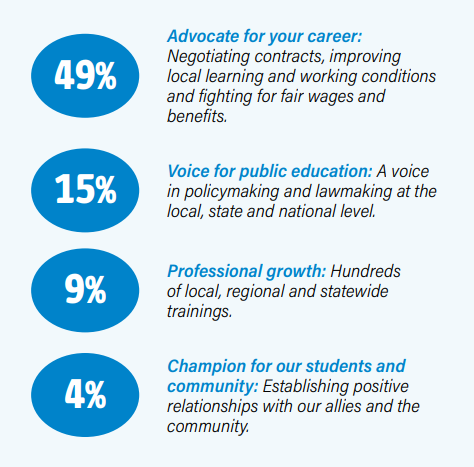No matter your role, working in a public school is one of the most difficult jobs, and it only gets more difficult as educators continue to face unprecedented challenges in their classrooms. But educators don’t have to face these challenges alone—by coming together through our union, our members find support and build collective power to advocate for our students, colleagues and communities.
When you join Education Minnesota, you join more than 87,000 educators across the state working together to negotiate fair contracts and advocate for strong public schools. Your Education Minnesota dues also make you a member of your local union, the National Education Association, the American Federation of Teachers and the AFL-CIO.
Where do my dues go?

Your dues fund Education Minnesota’s work to support members every day and promote union values, provide welcoming and relevant opportunities, focus on the recruitment and retention of members while providing programming for our members to ensure strong locals in the future.
You can view the breakdown in the chart to the right.
The rest—23%–goes towards union governance and infrastructure. That includes rent, utilities, equipment and tech support for 13 offices across the state.
Who is Education Minnesota’s leadership?
Education Minnesota leadership consists of three officers — president, vice president, and secretary/treasurer — and a 47-member governing board representing all parts of the state. Each of these leaders is elected by members and their purpose is to ensure the union’s organizational priorities are driven by members.
Every spring, hundreds of elected delegates attend the Representative Convention to set the organization’s goals and policy direction. The governing board and officers meet throughout the year to adopt a budget, set dues and carry out the action items passed at the Representative Convention.
Our organizational priorities are:
- Racial equity and social justice: Co-create equitable schools and anti-racist unions that welcome all students and educators, no matter their color, orientation, economic status, religion, abilities or zip code.
- Full funding for strong public schools: Establish and full and permanent funding system for public schools that guarantees students and educators have the resources they need to deliver the education our students deserve—from early childhood to post-secondary.
- Strong locals: Empower locals and members working collectively to be strong, trusted advocates for public education at the local and state levels.
Member-led standing committees
In addition to the officers and the governing board, Education Minnesota also has several standing committees, made up of members from across Minnesota. These committees each have a different focus, allowing members to work on the issues they care about most.
We have five standing committees:
• The Council of Local Presidents, which works with Education Minnesota leadership to communicate concerns and serves as a liaison between Education Minnesota and local presidents;
• The Ethnic Minority Affairs Committee, which advises the Human Rights Committee on ethnic minority issues in Education Minnesota and our schools;
• The Political Action Committee, which promotes the improvement of public schools through increasing political action among members and electing candidates who support Education Minnesota’s mission;
• The Legislative Action Committee. which considers and recommends legislative positions to the elected officers and leaders of Education Minnesota;
• The Professional Advocacy Committee, which considers and recommends policies and programs to the elected officers and other leaders regarding matters pertinent to the professional lives of members.
Our history
Minnesota was formed in 1998 when the Minnesota Education Association and the Minnesota Federation of Teachers merged. MEA, originally called the Minnesota State Teachers Association, started in 1861. MFT, originally known as the Grade Teachers Organization, was founded in 1898.
Education Minnesota is affiliated with the American Federation of Teachers, the National Education Association and the AFL-CIO. Through your membership, you belong to these organizations that collaborate to provide a unified voice for public education and for educators.
To learn more about Education Minnesota’s leadership and history, view the full list of standing committees or find out who represents you on the governing board, check out the “About Us” section of our website.


